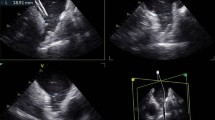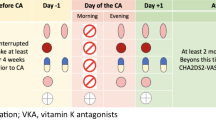Abstract
Background
Patients with atrial fibrillation (AF) usually experience a worsening of their AF burden over time. We aimed to investigate timing of pulmonary vein isolation (PVI) by cryoballoon (CB-2) after the first clinical diagnosis of AF on ablation-related outcomes.
Methods
A total of 132 consecutive patients with paroxysmal AF undergoing PVI by CB-2 were included in the study. The patients were retrospectively sorted into two groups to evaluate differences in AF recurrence risk associated with early ablation (n = 89), defined as within 365 days of first AF diagnosis, and late ablation (n = 365), defined as > 365 days after first AF diagnosis. AF-free survival during follow-up was compared between groups.
Results
Although mean procedure times were comparable between groups, mean fluoroscopy times were lower in the early ablation group. For the whole study group, median (interquartile range) time from AF diagnosis to first ablation was 4.0 (2.0–11.3) months [3.0 (1.0–4.0) vs 14.0 (12.0–22.5) months in the early and late ablation groups, respectively]. Median follow-up for the whole population was 12.0 (12.0–18.0) months, and after the blanking period, 14 (10.6%) patients had arrhythmia recurrence (2 in the early and 12 in the late ablation groups). In the univariable Cox regression analysis and propensity score adjusted penalized Cox regression analysis, there was a significant association between delay in ablation time and AF recurrence (unadjusted hazard ratio = 7.74, 95% CI 2.26–40.1, p < 0.001, adjusted hazard ratio = 7.50, 95% CI 2.23–38.6, p < 0.001).
Conclusion
Delays in treatment with CB-2 ablation may negatively affect AF-free survival rates among patients with paroxysmal AF.


Similar content being viewed by others
References
Wolf PA, Abbott RD, Kannel WB. Atrial fibrillation as an independent risk factor for stroke: the Framingham Study. Stroke. 1991;22:983–8.
Miyasaka Y, Barnes ME, Gersh BJ, Cha SS, Bailey KR, Abhayaratna WP, et al. Secular trends in incidence of atrial fibrillation in Olmsted County, Minnesota, 1980 to 2000, and implications on the projections for future prevalence. Circulation. 2006;114:119–25.
Schotten U, Verheule S, Kirchhof P, Goette A. Pathophysiological mechanisms of atrial fibrillation: a translational appraisal. Physiol Rev. 2011;91:265–325.
Allessie M, Ausma J, Schotten U. Electrical, contractile and structural remodeling during atrial fibrillation. Cardiovasc Res. 2002;54:230–46.
Hindricks G, Potpara T, Dagres N, Arbelo E, Bax JJ, Blomström-Lundqvist C, et al. ESC Scientific Document Group. 2020 ESC Guidelines for the diagnosis and management of atrial fibrillation developed in collaboration with the European Association for Cardio-Thoracic Surgery (EACTS). Eur Heart J. 2021;42:373–498.
Jahangir A, Lee V, Friedman PA, Trusty JM, Hodge DO, Kopecky SL, et al. Long-term progression and outcomes with aging in patients with lone atrial fibrillation: a 30-year follow-up study. Circulation. 2007;115:3050–6.
Camm AJ, Breithardt G, Crijns H, Dorian P, Kowey P, Le Heuzey JY, et al. Real-life observations of clinical outcomes with rhythm- and rate-control therapies for atrial fibrillation RECORDAF (Registry on Cardiac Rhythm Disorders Assessing the Control of Atrial Fibrillation). J Am Coll Cardiol. 2011;58:493–501.
Kirchhof P, Camm AJ, Goette A, Brandes A, Eckardt L, Elvan A, et al. EAST-AFNET 4 Trial Investigators. Early Rhythm-Control Therapy in Patients with Atrial Fibrillation. N Engl J Med. 2020;383:1305–16.
Humphries KH, Kerr CR, Steinbuch M, Dorian P. Canadian Registry of Atrial Fibrillation investigators. Limitations to antiarrhythmic drug use in patients with atrial fibrillation. CMAJ. 2004;171:741–5.
Bunch TJ, May HT, Bair TL, Johnson DL, Weiss JP, Crandall BG, et al. Increasing time between first diagnosis of atrial fibrillation and catheter ablation adversely affects long-term outcomes. Heart Rhythm. 2013;10:1257–62.
Kuck KH, Brugada J, Fürnkranz A, Metzner A, Ouyang F, Chun KR, et al. FIRE AND ICE Investigators. Cryoballoon or Radiofrequency Ablation for Paroxysmal Atrial Fibrillation. N Engl J Med. 2016;374:2235–45.
Aksu T, Golcuk SE, Guler TE, Yalin K, Erden I. Prediction of mid-term outcome after cryo-balloon ablation of atrial fibrillation using post-procedure high-sensitivity troponin level. Cardiovasc J Afr. 2015;26:165–70.
Aksu T, Baysal E, Guler TE, Golcuk SE, Erden İ, Ozcan KS. Predictors of atrial fibrillation recurrence after cryoballoon ablation. J Blood Med. 2015;6:211–7.
Wozakowska-Kaplon B. Changes in left atrial size in patients with persistent atrial fibrillation: a prospective echocardiographic study with a 5-year follow-up period. Int J Cardiol. 2005;101:47–52.
Schotten U, de Haan S, Neuberger HR, Eijsbouts S, Blaauw Y, Tieleman R, et al. Loss of atrial contractility is primary cause of atrial dilatation during first days of atrial fibrillation. Am J Physiol Heart Circ Physiol. 2004;287:2324–31.
Oakes RS, Badger TJ, Kholmovski EG, Akoum N, Burgon NS, Fish EN, et al. Detection and quantification of left atrial structural remodeling with delayed-enhancement magnetic resonance imaging in patients with atrial fibrillation. Circulation. 2009;119:1758–67.
Kuniss M, Pavlovic N, Velagic V, Hermida JS, Healey S, Arena G, et al. Cryo-FIRST Investigators. Cryoballoon ablation vs. antiarrhythmic drugs: first-line therapy for patients with paroxysmal atrial fibrillation. Europace. 2021;23:1033–41.
Wazni OM, Dandamudi G, Sood N, Hoyt R, Tyler J, Durrani S, et al. STOP AF First Trial Investigators. Cryoballoon Ablation as Initial Therapy for Atrial Fibrillation. N Engl J Med. 2021;384:316–24.
Charitos EI, Pürerfellner H, Glotzer TV, Ziegler PD. Clinical classifications of atrial fibrillation poorly reflect its temporal persistence: insights from 1,195 patients continuously monitored with implantable devices. J Am Coll Cardiol. 2014;63:2840–8.
Author information
Authors and Affiliations
Corresponding author
Ethics declarations
Ethics approval
Ethical committees of the study sites approved the study.
Informed consent
It has been waived due to retrospective design of the study.
Conflict of interest
The authors declare no competing interests.
Additional information
Publisher’s note
Springer Nature remains neutral with regard to jurisdictional claims in published maps and institutional affiliations.
Highlights
• The authors have evaluated the effect of early application of cryoballoon in treatment after the first clinical diagnosis of atrial fibrillation (AF) on AF recurrence.
• AF-free survival was higher in early intervention group compared to those with a delay in treatment.
Rights and permissions
About this article
Cite this article
Baysal, E., Okşul, M., Burak, C. et al. Decreasing time between first diagnosis of paroxysmal atrial fibrillation and cryoballoon ablation positively affects long-term consequences. J Interv Card Electrophysiol 65, 365–372 (2022). https://doi.org/10.1007/s10840-022-01167-3
Received:
Accepted:
Published:
Issue Date:
DOI: https://doi.org/10.1007/s10840-022-01167-3




